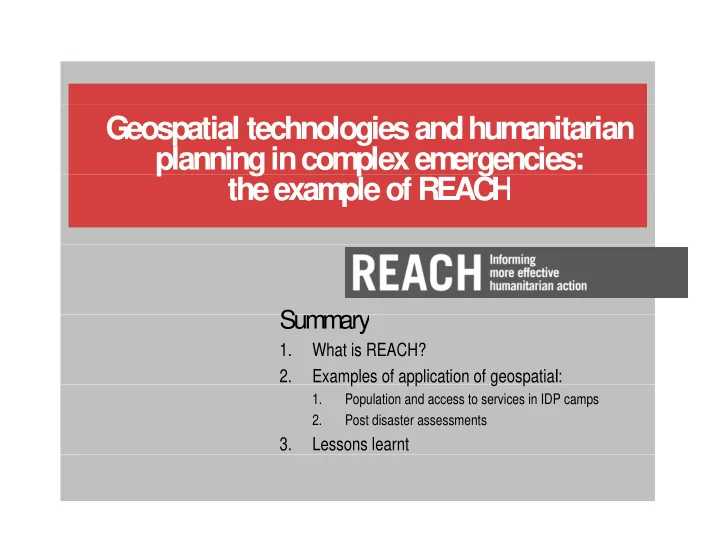

Geospatial technologies and hum anitarian planning planning in in com com plex em plex em ergencies: ergencies: the the exam exam ple of REACH ple of REACH Summary Summary 1. What is REACH? 2. 2. Examples of application of geospatia l : Examples of application of geospatia l : 1. Population and access to services in IDP camps 2. Post disaster assessments 3. Lessons learnt
TITLE 1 TITLE 1 TITLE 1 1 1 What is REACH W hat is REACH • REACH is an interagency initiative of ACTED, IMPACT Initiatives and UNOSAT. It was firstly piloted in 2010 and became operational and UNOSAT. It was firstly piloted in 2010 and became operational in 2012 • REACH aim s at filling hum anitarian inform ation gaps before, during and after em ergencies. REACH wants to prom ote evidence based planning and decision m planning and decision m aking am aking am ong hum ong hum anitarian actors anitarian actors • REACH systematically partners with key hum anitarian coordination platform platform s (such as clusters and m s (such as clusters and m andated UN andated UN agencies) to facilitate agencies) to facilitate interagency data collection and analysis in humanitarian settings.
TITLE 1 TITLE 1 TITLE 1 2 2 REACH’s toolbox REACH’s toolbox 4
REACH’s toolbox TITLE 1 TITLE 1 TITLE 1 4
TITLE 1 TITLE 1 TITLE 1 3 3 REACH’s deploym REACH’s deployments ents 4
TITLE 1 TITLE 1 TITLE 1 4 4 Use of geospatial technologies Use of geospatial technologies by REACH by REACH In its deployments, REACH uses remote sensing as a central data In its deployments, REACH uses remote sensing as a central data collection tool . Geospatial data is analysed by UNOSAT, with REACH assessment teams ground - truthing them in the field and promoting their use by humanitarian actors their use by humanitarian actors Following examples show use of geospatial technology in REACH Following examples show use of geospatial technology in REACH assessments to support humanitarian planning in the following conexts : - IDP camps of Somalia - Post disaster assessments in South Sudan, the Philippines - Post disaster assessments in South Sudan, the Philippines and Mali 4
Exam ple 1: Population and access to services in Som alia IDP cam ps TITLE 1 TITLE 1 TITLE 1 • REACH REACH deployed in support of deployed in support of Shelter, W ASH, Education and Health clusters Health clusters • Focus on facilitating humanitarian planning in IDP camps planning in IDP camps access • Difficult access require significant use of rem use of remote sensing, coupled with ote sensing, coupled with rapid field assessments 4
Exam ple 1: Shelter count and population density TITLE 1 TITLE 1 TITLE 1 4
Example 1: Access to services TITLE 1 TITLE 1 TITLE 1 4
Example 1: Analysis and planning TITLE 1 TITLE 1 TITLE 1 4
Example 2: Post disaster assessments TITLE 1 TITLE 1 TITLE 1 • In contexts of urban violence, In contexts of urban violence, damage a good proxy to understand affected areas understand affected areas and populations • • Geospatial technologies also Geospatial technologies also provide opportunities for rapid evaluation of damage and affected areas in the and affected areas in the aftermath of natural disasters 4
Exam ple 2: Bor, South Sudan 2014 TITLE 1 TITLE 1 TITLE 1 4
Exam ple 2: Juba, South Sudan 2014 TITLE 1 TITLE 1 TITLE 1 4
Exam ple 2: T acloban, Philippines 2013 TITLE 1 TITLE 1 TITLE 1 4
Exam ple 2: Flood m apping in M ali 2013 TITLE 1 TITLE 1 TITLE 1 4
TITLE 1 TITLE 1 TITLE 1 5 5 Lessons learnt Lessons learnt The use of remote sensing provides significant value - added for humanitarian planning, in particular in contexts of : • Man - made crises characterized by limited humanitarian access • Natural disasters requiring rapid information • Natural disasters requiring rapid information Despite significant improvement in geospatial technology and in its Despite significant improvement in geospatial technology and in its availability and affordability, it is still insufficiently used in humanitarian planning . Need to continue reinforcing links between agencies specialising in geospatial analysis and field - based humanitarian actors specialising in geospatial analysis and field - based humanitarian actors 4
Recommend
More recommend